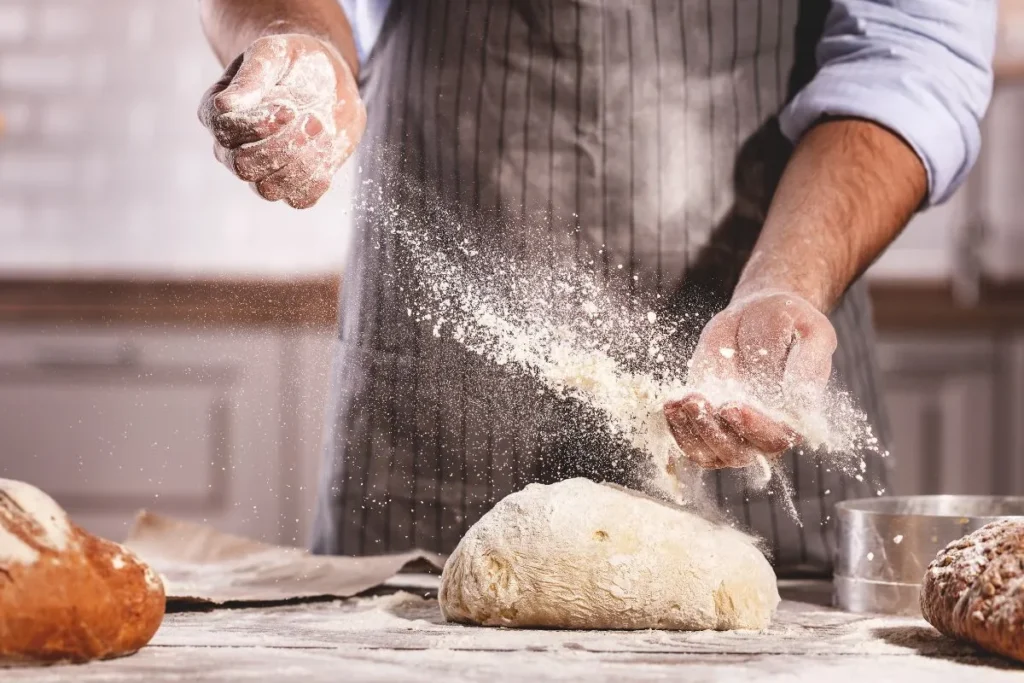
How To Fix Under Kneaded Dough In 6 Easy Ways
Baking is like an art, and even the pros can run into the problem of dough that’s not kneaded enough. But don’t worry, it happens to the best of us! In this guide, we’re gonna break down 6 simple and awesome ways to fix your under-kneaded dough.
So, let’s roll up our sleeves and transform your baking woes into wins!
Table of Contents
ToggleThe Importance of Kneading Dough
Getting your hands in the dough is a crucial part of baking—it totally shapes how your treats turn out. Kneading is all about working the dough to build up gluten, this protein that makes bread hold its form and bounce back.
Why does kneading matter? Well, it’s what makes your dough stick together and get that perfect structure. By folding and stretching the dough, you’re triggering the gluten to make sure your bread rises just right, giving it that light and fluffy feel. And it’s not just about texture—kneading also adds a nice chewiness to some baked goods.
But here’s the tasty part: kneading affects the flavor too. As the yeast does its thing with the flour, it releases these awesome flavors that really amp up the taste of your final masterpiece. Kneading evenly spreads those flavors throughout the whole dough.
And it’s not just a technical thing—it’s a hands-on, satisfying experience for bakers. It’s like getting in touch with your ingredients, turning simple stuff into a perfect mix of flavor and texture. So, kneading isn’t just a kitchen thing; it’s a celebration of skill and the secret to making your homemade treats the absolute best.

3 Common Problems with Under-Kneaded Dough
Dealing with dough that hasn’t been kneaded enough is a common problem in baking, and it brings a bunch of challenges that can mess up how your final baked goods turn out. Knowing about these issues is key for any baker trying to nail it with their creations.
- Not Enough Structure and Stretchiness: When you don’t knead your dough enough, it messes with the development of gluten. Gluten is what gives your dough its structure and stretchiness, and without enough of it, the dough can’t hold onto the gas that builds up during fermentation. That means your bread might not rise properly, ending up dense and flat instead of nice and fluffy.
- Fermentation Falls Short: Fermentation is a big deal in making bread, and it depends on the yeast and sugars in the dough getting along. But under-kneaded dough messes with this, because the yeast and sugars aren’t spread out right. This can leave your bread with a weak flavor, missing the rich taste that a well-fermented dough brings.
- Tricky to Shape and Handle: Dough that’s under-kneaded tends to be sticky and hard to control, especially when you’re trying to shape it. This can be a real pain, especially if you’re going for fancy shapes or trying to make your bread look awesome. The lack of stick-to-itself-ness makes the dough prone to tearing and falling apart when you’re shaping it, ending up with a final product that doesn’t look as good as it could.
Signs of Under-Kneaded Dough
These signs provide valuable insights into the state of your dough, allowing you to take corrective measures before it’s too late.
- Sticky Feel: If your dough feels sticky and kind of tacky, it might be a hint that it needs more kneading. When the gluten isn’t up to par, your dough won’t have the structure it needs. Dealing with this stickiness can make baking a real headache, getting all messy and frustrating.
- Not Stretchy Enough: Dough that hasn’t been kneaded well won’t stretch like it should. Instead of stretching, it might just tear when you pull it. This lack of stretchiness tells you that the gluten network isn’t doing its job, which can mess with your dough’s rise when it’s baking.
- Flat and Heavy Baked Goods: If your dough hasn’t been kneaded enough, it’ll show in the final product. Your bread or whatever you’re baking might end up flat and heavy. Without good gluten development, the dough can’t trap the gases from fermentation properly, leading to less volume and a not-so-great texture.
- Tricky to Shape: Under-kneaded dough can be a pain to shape. It won’t have the flexibility or structure needed for fancy shaping techniques. Bakers might struggle with the dough tearing or falling apart during shaping, making it hard to get the look they want.
- Uneven Texture: Once your under-kneaded dough is baked, you might notice it has a wonky texture. Instead of a consistent texture with evenly spread air pockets, you could see big and irregular holes. This unevenness is another sign that the gluten development didn’t make the cut.

How to Fix Under Kneaded Dough in 6 Easy Methods
Let’s explore six easy methods to rescue your dough and turn your baking experience around.
1. Adjusting Kneading Time
One of the primary reasons for under kneaded dough is not giving it enough time in the kneading department. Kneading is not just a ritual; it’s a crucial step in gluten development. Adjusting the kneading time ensures that your dough gets the attention it deserves.
Start by consulting your recipe for the recommended kneading duration. If you’ve been cutting corners, extend the kneading time gradually. This allows the gluten to properly form, giving your dough the structure it needs. Remember, patience in kneading pays off in the texture of your final creation.
2. Incorporating Additional Flour Gradually
Is your dough feeling a bit too sticky and uncooperative? The solution might lie in the gradual addition of flour. However, the key is not to rush. Slowly introduce small amounts of flour into the dough, ensuring you maintain control over the consistency.
Adding flour gradually prevents overcompensation, which can lead to a dry and tough end product. The goal is to achieve the perfect balance, where the dough is no longer sticky but retains its elasticity. Experiment with this method, and you’ll find your sweet spot.
3. Optimal Water Adjustment
Balancing hydration is a delicate dance in the world of baking. If your dough is under kneaded, the water content might be a culprit. Adjusting the water gradually can bring your dough back to life.
Start by assessing the dough’s texture. If it feels too dry and crumbly, add water in small increments. Conversely, if it’s overly sticky, reduce the water content. The key is to make gradual adjustments, giving the dough time to absorb and redistribute the moisture evenly.

4. Utilizing the Folding Technique
Sometimes, fixing under kneaded dough requires a bit of finesse. Enter the folding technique—a simple yet effective method to enhance gluten development. This technique involves gently folding the dough over itself, creating layers that contribute to improved structure and texture.
To employ this method, flatten the dough, fold it in half, and repeat. The goal is to create layers that strengthen the dough without excessive kneading. It’s a forgiving technique that allows you to correct under kneading without compromising the integrity of your dough.
5. Extended Rest Periods
In the rush of baking excitement, it’s easy to overlook the power of patience. Allowing your dough extended rest periods can work wonders in fixing under kneaded dough. This technique is especially beneficial when other methods may not suffice.
After kneading, let your dough rest and rise for a longer duration than the recipe suggests. This gives the gluten more time to develop, compensating for the initial under kneading. Be mindful not to rush this step; the results are worth the extra time.
6. The Power of Temperature Control
Temperature plays a significant role in dough development. If you find yourself dealing with under kneaded dough, consider adjusting the temperature during the kneading process.
Warmer temperatures encourage yeast activity and gluten development. On the other hand, cooler temperatures slow down these processes. Experiment with controlling the temperature during kneading to find the sweet spot for your specific dough type.
How To Fix Under Kneaded Dough | Final Thoughts
Baking is like a cool mix of science and art, and getting the kneading part down is key to making awesome treats. We’ve dug into how gluten plays a big role in making your baked goods have the right structure and flavor. We’ve checked out the common problems when you don’t knead enough and the signs to look out for.
But no worries, we’ve got six super reliable ways to save your dough and take your baking skills up a notch. From tweaking how long you knead to mastering the fancy folding move, these steps make sure your dough gets the love it needs. So, be patient with that kneading hand of yours, and let the sweet smell of success take over your kitchen. Happy baking!
Lindsey Mackenzie
About me
Hi there! I’m Lindsey Mackenzie, the founder of Bake Smartly. Baking has been my passion since childhood, growing up in my father’s bakery. With Bake Smartly, I’m excited to share my love for all things sweet and savory. Join me on this delicious journey as we whip up scrumptious treats and sprinkle joy into every bite!






